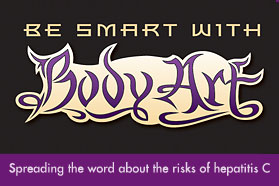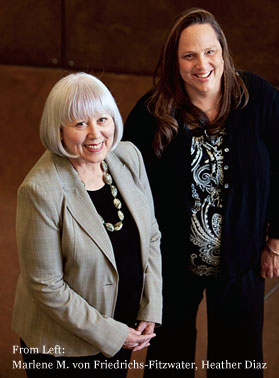Outreach: Be smart with body art
 Degner was 17 then, a high school senior whose friend knew a guy performing body art in his Sacramento garage.
Degner was 17 then, a high school senior whose friend knew a guy performing body art in his Sacramento garage.
"It was fast, it was cheap and he didn't check my ID," recalled Degner, now 29. "Just like that, I had a butterfly on my back and my five minutes of fame on campus."
Fortunately, the young student did not contract a blood-borne virus from the experience. Older and wiser now, Degner still loves her tattoo but wants other teens to take precautions before making a similar leap. As part of an educational campaign jointly sponsored by the UC Davis Cancer Center and Sacramento State University, she is warning college students about the risks of contracting hepatitis C virus (HCV) and other dangerous viruses from tattoos and body-piercing.
 A startling 40 percent of students believed tattooing and body piercing were unlikely to pose health risks.
A startling 40 percent of students believed tattooing and body piercing were unlikely to pose health risks.
The multimedia campaign, dubbed "Be Smart with Body Art," got off the ground late last year with the launch of a Web site and production of a video available on YouTube. Educators on the two campuses initiated the project after a survey found that a startling 40 percent of students believed tattooing and body piercing were unlikely to pose health risks.
The survey also revealed that students knew little about hepatitis C – a chronic disease with no cure that is a leading cause of liver cancer – or how it is spread, according to Marlene M. von Friederichs-Fitzwater, a faculty member with the cancer center and UC Davis School of Medicine, and director of the UC Davis Cancer Center Outreach Research and Education Program.
"There were a lot of misconceptions about it," she says. "Many students thought they had already been vaccinated against it, most likely confusing it with hepatitis B. In fact, there is no cure for hepatitis C, and treatments are only about 40 percent effective in controlling it."
Von Friederichs-Fitzwater and her principal partner in the project, Sacramento State health sciences professor Heather Diaz, says their aim is not to ban, or even discourage tattooing and piercing. Body art has been around for thousands of years, they note, and young people today are embracing it in unprecedented numbers.
Instead, their goal is to ensure that those seeking tattoos or piercings simply ask some important questions about sterilization and other practices before going under the needle. Many customers may believe body art parlors are required to observe minimum safety standards, but they are in fact largely unregulated businesses in California and many other states.
"The goal is to help students make sound decisions and think twice before acting on the spur of the moment," Diaz says. "One of our targets is the girl who goes to a party and, on impulse, decides to get a little half-inch heart on her body and winds up years later suffering from hepatitis C."
For von Friederichs-Fitzwater, the issue is as personal as it is professional, because one of her grown sons is battling chronic HCV and resulting liver cirrhosis.
 "The place looked clean, and they shaved my arm and cleaned it with alcohol. They opened the needles so the package was new. But to tell you the truth, I wasn't too worried. I'd heard the place was pretty legit."
"The place looked clean, and they shaved my arm and cleaned it with alcohol. They opened the needles so the package was new. But to tell you the truth, I wasn't too worried. I'd heard the place was pretty legit."
Two years ago, at the age of 50, Richard was diagnosed with the disease and given six months to live. He is still undergoing alternative treatments and believes he picked up the virus from a tattoo in the 1970s or 1980s.
"Like many patients, my son had this disease for years and never knew it because he had no symptoms," von Friederichs-Fitzwater says. "That's one reason hepatitis C is often called ‘the silent epidemic.'"
Epidemic is not an understatement, she added, because experts predict hepatitis C eventually will kill more people worldwide than AIDS. Nearly eight in 10 people infected with the virus go on to develop chronic hepatitis C, putting them at risk of liver disease, cirrhosis and liver cancer.
Despite its severity, hepatitis C is not well-understood by the public – students included. Many believe it is a disease that affects only prisoners and intravenous drug users, but that perception is outdated.
"I think when students think about hepatitis at all, they think about the kind you get from a bad salad bar," Diaz says, referring to hepatitis A, which is spread differently and is typically not deadly. "There really is very little awareness of how serious this disease is and how easy it is to get it."
Jeremy Scott, a senior majoring in engineering at UC Davis, is among those acknowledging that they have "no idea" how big a health threat hepatitis C can be. Scott got his two tattoos – one on each shoulder – at a shop in Davis from an apprentice who was giving them out for free.
"The place looked clean, and they shaved my arm and cleaned it with alcohol," says Scott, 23. "They opened the needles so the package was new. But to tell you the truth, I wasn't too worried. I'd heard the place was pretty legit."
When UC Davis senior Curt di Cristina went into a local shop called Urban Body for his ankle tattoo, he was somewhat more informed about the disease, in part because he had worked at his father's dental office, where sterilization is a workplace priority. Di Cristina and a handful of brothers in his Sigma Chi fraternity have tattoos depicting the fraternity's letters and three dots symbolizing its organizational aims – friendship, justice and learning.
 Their aim is not to ban, or even discourage tattooing and piercing. Instead, their goal is to ensure that those seeking tattoos or piercings simply ask some important questions about sterilization and other practices before going under the needle.
Their aim is not to ban, or even discourage tattooing and piercing. Instead, their goal is to ensure that those seeking tattoos or piercings simply ask some important questions about sterilization and other practices before going under the needle.
"The health risk was definitely something I worried about going in, because when you're using needles, there is potential for HIV or a lot of other scary, bad diseases," di Cristina says. "But when I saw that the artist was using a type of sterilization instrument my father uses, that allayed a lot of my fears."
To reach students, Be Smart with Body Art campaign organizers are working on multiple fronts, and have enlisted support from leaders of the professional tattooists and body piercers associations as well as representatives from the piercing and tattooing industries. They have aired radio ads; run TV spots in English, Cantonese and Vietnamese; distributed materials to student health centers at colleges and universities in California; and planned campus events to highlight the hazards and provide students with five simple safety questions to ask before obtaining body art.
Working with the student public health club at Sacramento State, leaders of the effort also plan to hold workshops for incoming residents of campus dormitories.
"We're trying to hit freshmen coming in because that's when they feel the need to let loose," says Jasmine Pettis, 22, who is president of the public health club and, with three tattoos, has some personal experience to lend the campaign.
"We want to make sure students don't just get drunk one weekend and get a tattoo in someone's garage."
Degner, for one, hopes the message gets through.
"I'm living proof of what not to do," says Degner, a Sacramento State senior heading to nursing school in the fall. "I can't change the past, but I can help others avoid the mistake I made."










